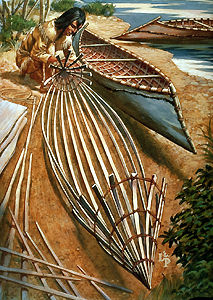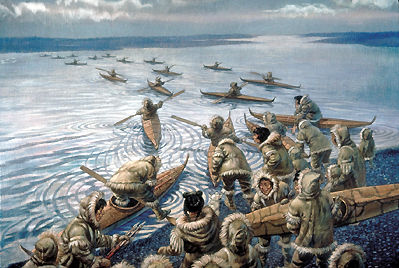Browse "Indigenous Peoples"
-
Article
Jordin Tootoo
Jordin John Kudluk (Thunder) Tootoo, hockey player (born 2 February, 1983 in Churchill, MB). Jordin Tootoo is the first Inuk hockey player to play in the National Hockey League (NHL). Jordin got the attention of the NHL as a tough, talented right-winger in his junior hockey days in Manitoba. In 2003, he received national attention when he played for Team Canada at the World Junior Hockey Championship. After playing 13 seasons in the NHL, he retired in 2018. He is known for speaking to youth and maintaining his Inuit culture.
"https://d2ttikhf7xbzbs.cloudfront.net/media/new_article_images/JordinTootoo/Jordin Tootoo 2012 photo.jpg" // resources/views/front/categories/view.blade.php
https://d2ttikhf7xbzbs.cloudfront.net/media/new_article_images/JordinTootoo/Jordin Tootoo 2012 photo.jpg
-
Article
Jose Kusugak
Jose Amaujaq Kusugak, ONu, Inuit politician, community leader, teacher, activist, linguist and broadcaster (born 2 May 1950 in Repulse Bay, NT [now Naujaat, NU]; died 18 or 19 January 2011 in Rankin Inlet, Kivalliq, NU). Kusugak was president of Nunavut Tunngavik Inc. from 1994 to 2000. This was the organization responsible for negotiating and implementing the land claim that ultimately resulted in the creation of Nunavut in 1999. For this reason, some consider Kusugak a Father of Confederation. He was also a lifelong advocate for Inuit rights, language and culture.
"https://d2ttikhf7xbzbs.cloudfront.net/JoseKusugak/CanadaPostJoseKusugak.jpg" // resources/views/front/categories/view.blade.php
https://d2ttikhf7xbzbs.cloudfront.net/JoseKusugak/CanadaPostJoseKusugak.jpg
-
Article
Joseph Benjamin Keeper
Joseph Benjamin “Joe” Keeper, world-class athlete and war hero of the Norway House Cree Nation (born 21 January 1886 in Walker Lake, MB; died 29 September 1971 in Winnipeg, MB). Keeper competed at the 1912 Stockholm Summer Olympics, where he participated in the 5,000 and 10,000 m track events. Keeper later served in the Canadian Expeditionary Force during the First World War and received the Military Medal for his actions at the front. After his death, Keeper was inducted into the Canadian Olympic Hall of Fame in 1977 and Canada’s Sports Hall of Fame in 2015.
"https://d2ttikhf7xbzbs.cloudfront.net/JosephKeeper/Joe Keeper_LAC_a002734-v8.jpg" // resources/views/front/categories/view.blade.php
https://d2ttikhf7xbzbs.cloudfront.net/JosephKeeper/Joe Keeper_LAC_a002734-v8.jpg
-
Article
Joseph Sánchez
Joseph Marcus Sánchez, artist, curator (born 24 February 1948 in Trinidad, Colorado, United States). In 1970, Joseph Sánchez travelled to Canada, settling in Richer, Manitoba. He became a founding member of Professional Native Indian Artists Inc., known widely as the Indian Group of Seven. Sánchez remained in Canada until 1975-76, leaving a lasting impact on the recognition and exposure of First Nations art and artists. Sánchez went on to become a community elder and political activist. He has worked as a museum director and curator for major galleries and exhibitions. His artwork has been exhibited extensively in Canada, the United States and Europe, and he has provided essays for a number of exhibition catalogues.
"https://d2ttikhf7xbzbs.cloudfront.net/JosephSanchez/SanchezCropped.jpg" // resources/views/front/categories/view.blade.php
https://d2ttikhf7xbzbs.cloudfront.net/JosephSanchez/SanchezCropped.jpg
-
Article
Josephine Mandamin
Josephine Henrietta Mandamin, Anishinaabe Elder, water-rights advocate, Anishinabek Nation Chief Water Commissioner (born 21 February 1942 in Wiikwemikoong Unceded Territory, Manitoulin Island, ON; died 22 February 2019). Elder Josephine Mandamin, known as “Grandmother Water Walker” and Biidaasige-ba (“the one who comes with the light”), was a world-renowned water-rights activist. She walked around the Great Lakes from 2003 to 2017 to bring awareness to the problems of water pollution and environmental degradation on the Great Lakes and on Indigenous reserves in Canada. For her activism, Mandamin was awarded the Anishinabek Lifetime Achievement Award (2012) and the Governor General’s Meritorious Service Cross (2018). Her great-niece, Autumn Peltier, followed in Mandamin’s footsteps, becoming the next generation’s “water warrior.”
"https://d2ttikhf7xbzbs.cloudfront.net/Mandamin/Mandamin_stamp_resized.jpg" // resources/views/front/categories/view.blade.php
https://d2ttikhf7xbzbs.cloudfront.net/Mandamin/Mandamin_stamp_resized.jpg
-
Article
Kashtin
Kashtin is a popular Montagnais duo consisting of the singer-songwriters and guitarists Florent Vollant (born 10 August 1959 in Maliotenam, near Sept Îles, QC) and Claude McKenzie (born 11 March 1967 in Schefferville, QC). Kashtin means “tornado” in the Montagnais' Innu-aimun language. Kashtin's songs, in country or contemporary folk styles, are characterized by simple but spirited refrains sung in throaty harmony over vigorous, acoustic guitar rhythms. The duo’s debut album, Kashtin (1989), received Félix awards in 1990 as best debut and best country-folk album.
"https://d2ttikhf7xbzbs.cloudfront.net/1024px-Kashtin_2019.jpg" // resources/views/front/categories/view.blade.php
https://d2ttikhf7xbzbs.cloudfront.net/1024px-Kashtin_2019.jpg
-
Article
Kaska Dena
The Kaska Dena or Denek’éh (often referred to simply as Kaska) are a Dene-speaking people who live in southern Yukon and northern British Columbia, primarily in the communities of Lower Post, Upper Liard (near Watson Lake), Watson Lake and Ross River in the Pelly drainage. In the 2021 census, 980 people reported being of Kaska ancestry.
"https://development.thecanadianencyclopedia.ca/images/tce_placeholder.jpg?v=e9dca980c9bdb3aa11e832e7ea94f5d9" // resources/views/front/categories/view.blade.php
https://development.thecanadianencyclopedia.ca/images/tce_placeholder.jpg?v=e9dca980c9bdb3aa11e832e7ea94f5d9
-
Article
Kenojuak Ashevak
Kenojuak Ashevak, C.C., ONu, artist (born 3 October 1927 in Ikerrasak camp, South Baffin Island, NWT; died 8 January 2013, Cape Dorset, NU). A Companion of the Order of Canada and winner of the Governor General’s Award in Visual and Media Arts, Ashevak is perhaps the best-known Inuit artist because of her famous print The Enchanted Owl (1960), which was featured on a Canada Post stamp. She was also the first woman to become involved with the newly established printmaking shop at Cape Dorset.
"https://d2ttikhf7xbzbs.cloudfront.net/media/media/45b62e3e-a9c3-42e3-a780-7b5dd7889ffc.jpg" // resources/views/front/categories/view.blade.php
https://d2ttikhf7xbzbs.cloudfront.net/media/media/45b62e3e-a9c3-42e3-a780-7b5dd7889ffc.jpg
-
Article
Kondiaronk
Kondiaronk, Tionontati chief (born circa 1649; died 2 August 1701 in Montreal, QC). He has been known by several names throughout history, including Gaspar Soiaga, Souoias, Sastaretsi, and Le Rat (the Rat). Kondiaronk was one of the main brokers of the Great Peace of Montreal, signed in 1701. This peace agreement between the French and Haudenosaunee brought to an end almost a century of hostilities marked by atrocities on both sides. (See also Indigenous-French Relations in Canada.)
"https://d2ttikhf7xbzbs.cloudfront.net/Kondiaronk/KondiaronkStamp.jpg" // resources/views/front/categories/view.blade.php
https://d2ttikhf7xbzbs.cloudfront.net/Kondiaronk/KondiaronkStamp.jpg
-
Article
Ktunaxa (Kootenay)
The Ktunaxa (Kootenay) are an Indigenous people who traditionally occupied territories in southeastern British Columbia, as well as in parts of Alberta, Idaho, Montana and Washington. The term “Kootenay” may be an anglicized form of an old Ktunaxa word. In the 2016 census, 935 people identified as having Ktunaxa ancestry.
"https://d2ttikhf7xbzbs.cloudfront.net/media/media/c6ee12de-e628-4471-b4e7-db4c40e30884.jpg" // resources/views/front/categories/view.blade.php
https://d2ttikhf7xbzbs.cloudfront.net/media/media/c6ee12de-e628-4471-b4e7-db4c40e30884.jpg
-
Article
Ksan
Ksan (or ‘Ksan) is a historical village, museum and campground, owned and operated by the Gitanmaax Band. It is located at the junction of the Skeena and Bulkley rivers in Hazelton, British Columbia. Ksan was established in 1970 as way to promote and preserve Gitxsan culture and history.
"https://d2ttikhf7xbzbs.cloudfront.net/media/media/2fd73ae3-5ed7-4894-b6ae-caa2ac25e639.jpg" // resources/views/front/categories/view.blade.php
https://d2ttikhf7xbzbs.cloudfront.net/media/media/2fd73ae3-5ed7-4894-b6ae-caa2ac25e639.jpg
-
Article
Kwakwaka’wakw (Kwakiutl)
The Kwakwaka'wakw peoples are traditional inhabitants of the coastal areas of northeastern Vancouver Island and mainland British Columbia. In the 2016 census, 3,670 people self-identified as having Kwakwaka’wakw ancestry. Originally made up of approximately 28 communities speaking dialects of Kwak’wala — the Kwakwaka'wakw language —the number of communities was reduced by approximately half. After sustained contact beginning in the late 18th century, Europeans applied the name of one nation, the Kwakiutl, to the whole group in 1849, a tradition that persisted. The name Kwakwaka’wakw means those who speak Kwak’wala, which itself includes multiple dialects. (See also Northwest Coast Indigenous Peoples in Canada.)
"https://d2ttikhf7xbzbs.cloudfront.net/media/media/0f3f1bc5-ec8b-4f16-b0a3-4f0f553a5cca.jpg" // resources/views/front/categories/view.blade.php
https://d2ttikhf7xbzbs.cloudfront.net/media/media/0f3f1bc5-ec8b-4f16-b0a3-4f0f553a5cca.jpg
-
Article
Labrador Inuit (Labradormiut)
Labrador Inuit (Labradormiut) are descendants of the Early Inuit (Thule) people and have historically occupied most of the Atlantic coast of Northern Labrador. In 2005, the Labrador Inuit celebrated the enactment of the first Nunatsiavut Government, a self-governing Inuit regional government, the product of three decades of land claims negotiations with the federal government.
"https://d2ttikhf7xbzbs.cloudfront.net/media/media/8cfbeb31-b9b9-4783-a639-4cee826bec5b.jpg" // resources/views/front/categories/view.blade.php
https://d2ttikhf7xbzbs.cloudfront.net/media/media/8cfbeb31-b9b9-4783-a639-4cee826bec5b.jpg
-
Article
Indigenous Land Claims in Canada
Land claims seek to address wrongs made against Indigenous peoples, their rights and lands, by the federal and provincial or territorial governments. There are different types of land claims. Comprehensive claims (also known as modern treaties) deal with Indigenous rights, while specific claims concern the government’s outstanding obligations under historic treaties or the Indian Act. There are many ongoing comprehensive and specific claims negotiations in Canada.
"https://d2ttikhf7xbzbs.cloudfront.net/media/media/174cee51-4aca-4a67-ac60-f72697d35862.jpg" // resources/views/front/categories/view.blade.php
https://d2ttikhf7xbzbs.cloudfront.net/media/media/174cee51-4aca-4a67-ac60-f72697d35862.jpg
-
Article
Larry Grant (sʔəyəɬəq)
Larry Grant (also known as sʔəyəɬəq (suh-yuh-shl-uck) and Hong Lai Hing), storyteller, Musqueam Elder, educator of endangered First Nation language hən̓q̓əmin̓əm̓ (born 1 September 1936 in Agassiz, BC). Grant is of Musqueam and Chinese ancestry, raised on the Musqueam territory at the mouth of the Fraser River. The unceded territory of the Musqueam peoples encompasses what is known today as Vancouver, extending up to Harvey Creek in the north and Fraser River to the east. After retiring as a longshoreman, Grant dedicated his life to promoting knowledge of the hən̓q̓əmin̓əm̓ language and its cultural value. He is also an adjunct professor and an Elder-In-Residence at the University of British Columbia. Grant is recognized as a community leader who fosters dialogue and understanding of Musqueam history and language in British Columbia.
"https://d2ttikhf7xbzbs.cloudfront.net/LarryGrant/Elder_Larry_Grant_web.jpeg" // resources/views/front/categories/view.blade.php
https://d2ttikhf7xbzbs.cloudfront.net/LarryGrant/Elder_Larry_Grant_web.jpeg
